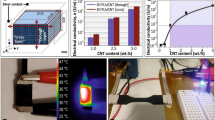Abstract
Smart composites with tunable stress–strain curves are explored in a numerical setting. The macroscopic response of the composite is endowed with tunable characteristics through microscopic constituents which respond to external stimuli by varying their elastic response in a continuous and controllable manner. This dynamic constitutive behavior enables the composite to display characteristics that cannot be attained by any combination of traditional materials. Microscopic adaptation is driven through a repetitive controller which naturally suits the class of applications sought for such composites where loading is cyclic. Performance demonstrations are presented for the overall numerical framework over complex paths in macroscopic stress–strain space. Finally, representative two- and three-dimensional tunable microstructures are addressed by integrating the control approach within a computational environment that is based on the finite element method, thereby demonstrating the viability of designing and analyzing smart composites for realistic applications.


















Similar content being viewed by others
References
Kaw AK (2005) Mechanics of composite materials, 2nd edn. CRC Press, Boca Raton
Zohdi TI (2003) Constrained inverse formulations in random material design. Comput Methods Appl Mech Eng 192:3179–3194
Guest JK (2015) Optimizing the layout of discrete objects in structures and materials: a projection-based topology optimization approach. Comput Methods Appl Mech Eng 283:330–351
Kiyono CY, Silva ECN, Reddy JN (2012) Design of laminated piezocomposite shell transducers with arbitrary fiber orientation using topology optimization approach. Int J Numer Methods Eng 90(12):1452–1484
Khani A, Abdalla MM, Gürdal Z (2015) Optimum tailoring of fibre-steered longitudinally stiffened cylinders. Compos Struct 122:343–351
Lee J-H, Singer JP, Thomas EL (2012) Micro-/nanostructured mechanical metamaterials. Adv Mater 24:4782–4810
Bendsøe MP, Sigmund O (2004) Topology optimization: theory, methods and applications, 2nd edn. Springer, Berlin
Christensen PW, Klarbring A (2010) An introduction to structural optimization. Springer, Berlin
Sigmund O, Torquato S (1996) Composites with extremal thermal expansion coefficients. Appl Phys Lett 69:3203–3205
Sigmund O (2000) A new class of extremal composites. J Mech Phys Solids 48:397–428
Chen B-C, Silva ECN, Kikuchi N (2001) Advances in computational design and optimization with application to MEMS. Int J Numer Methods Eng 52(1–2):23–62
Nakshatrala PB, Tortorelli DA, Nakshatrala KB (2013) Nonlinear structural design using multiscale topology optimization. Part I: static formulation. Comput Methods Appl Mech Eng 261–262:167–176
Kato J, Yachi D, Terada K, Kyoya T (2014) Topology optimization of micro-structure for composites applying a decoupling multi-scale analysis. Struct Multidiscip Optim 49:595–608
Rafsanjani A, Akbarzadeh A, Pasini D (2015) Snapping mechanical metamaterials under tension. Adv Mater 27:5931–5935
Haghpanah B, Salah-Sharif L, Pourrajab P, Hopkins J, Valdevit L (2016) Multistable shape-reconfigurable architected materials. Adv Mater 28:7915–7920
Restrepo D, Mankame ND, Zavattieri PD (2016) Programmable materials based on periodic cellular solids. Part I: experiments. Int J Solids Struct 100–101:485–504
Shan W, Lu T, Majidi C (2013) Soft-matter composites with electrically tunable elastic rigidity. Smart Mater Struct 22:085005
Shan W, Diller S, Tutcuoglu A, Majidi C (2015) Rigidity-tuning conductive elastomer. Smart Mater Struct 24:065001
Kallio M (2005) The elastic and damping properties of magnetorheological elastomers. Ph.D. thesis, Tampere University of Technology, Tampere, Finland
Li WHG, Zhou Y, Tian TF (2010) Viscoelastic properties of MR elastomers under harmonic loading. Rheol Acta 49:733–740
Kallio M, Lindroos T, Aalto S, Järvinen E, Kärnä T, Meinander T (2007) Dynamic compression testing of a tunable spring element consisting of a magnetorheological elastomer. Smart Mater Struct 16:506–514
Li Y, Li J, Li W, Du H (2014) A state-of-the-art review on magnetorheological elastomer devices. Smart Mater Struct 23:123001
Lee D, Lee M, Jung N, Yun M, Lee J, Thundat T, Jeon S (2014) Modulus-tunable magnetorheological elastomer microcantilevers. Smart Mater Struct 23:055017
Kuder IK, Arrieta AF, Raither WE, Ermanni P (2013) Variable stiffness material and structural concepts for morphing applications. Prog Aerosp Sci 63:33–55
Churchill CB, Shahan DW, Smith SP, Keefe AC, McKnight GP (2016) Dynamically variable negative stiffness structures. Sci Adv 2:e1500778
Jackson JA, Messner MC, Dudukovic NA, Smith WL, Bekker L, Moran B, Golobic AM, Pascall AJ, Duoss EB, Loh KJ, Spadaccini CM (2018) Field responsive mechanical metamaterials. Sci Adv 4:eaau6419
Roh S, Okello LB, Golbasi N, Hankwitz JP, Liu JAC, Tracy JB, Velev OD (2019) 3D-printed silicone soft architectures with programmed magneto-capillary reconfiguration. Adv Mater Technol 4(4):1800528
Pavliotis GA, Stuart AM (2008) Multiscale methods: averaging and homogenization. Springer, Berlin
Torquato S (2002) Random heterogeneous materials: microstructure and macroscopic properties. Springer, Berlin
Zohdi TI, Wriggers P (2005) Introduction to computational micromechanics. Springer, Berlin
Ogata K, Yang Y (2002) Modern control engineering, 4th edn. Prentice Hall, London
Desoer CA, Vidyasagar M (1975) Feedback systems: input-output properties, vol 55. SIAM, Philadelphia
Zhou K, Doyle JC, Glover K (1996) Robust and optimal control. Prentice Hall, Philadelphia
Chen CT (2013) Linear system theory and design. Oxford series in electrical and computer engineering. Oxford University Press, Oxford
Özcan M (2018) Smart composites with tunable stress–strain curves. Master’s thesis, Bilkent University, Bilkent, Turkey
Hara S, Omata T, Nakano M (1985) Synthesis of repetitive control systems and its application. In: Decision and control, 1985 24th IEEE conference on, vol 24, pp 1387–1392. IEEE
Francis BA, Wonham WM (1975) The internal model principle of linear control theory. IFAC Proc Vol 8(1):331–336
Wang Y, Gao F, Doyle FJ (2009) Survey on iterative learning control, repetitive control, and run-to-run control. J Process Control 19(10):1589–1600
Hara S, Yamamoto Y, Omata T, Nakano M (1988) Repetitive control system: a new type servo system for periodic exogenous signals. IEEE Trans Autom Control 33(7):659–668
Author information
Authors and Affiliations
Corresponding author
Additional information
Publisher's Note
Springer Nature remains neutral with regard to jurisdictional claims in published maps and institutional affiliations.
Rights and permissions
About this article
Cite this article
Özcan, M., Cakmakci, M. & Temizer, İ. Smart composites with tunable stress–strain curves. Comput Mech 65, 375–394 (2020). https://doi.org/10.1007/s00466-019-01773-5
Received:
Accepted:
Published:
Issue Date:
DOI: https://doi.org/10.1007/s00466-019-01773-5




